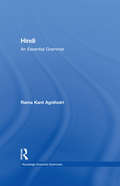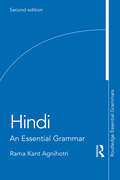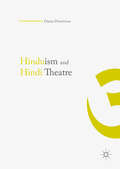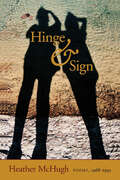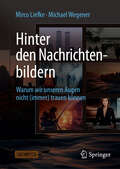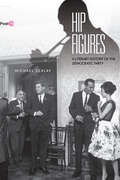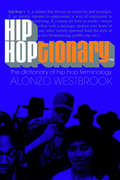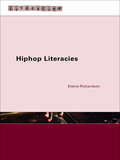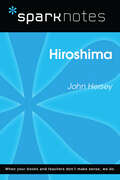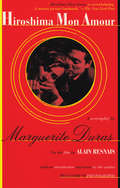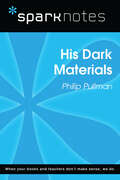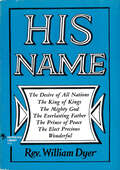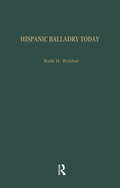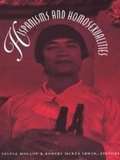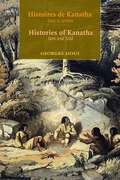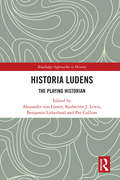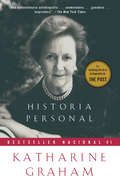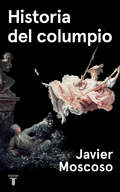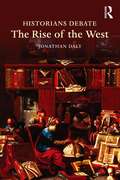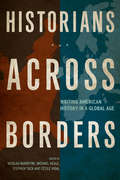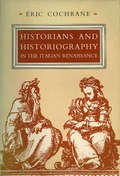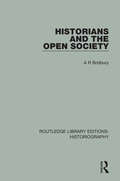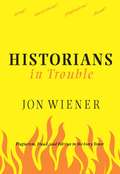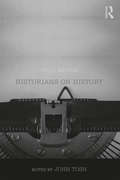- Table View
- List View
Hindi: An Essential Grammar (Routledge Essential Grammars)
by Rama Kant AgnihotriThis text provides a reader-friendly guide to the structural patterns of modern standard Hindi. Ideal for both independent learners and classroom students alike, this book covers the essentials of Hindi grammar in readable, jargon-free sections. Key features include: sections on the speech sounds of Hindi detailed analysis of Hindi sentence structure full examples throughout.
Hindi: An Essential Grammar (Routledge Essential Grammars)
by Rama Kant AgnihotriHindi: An Essential Grammar is a practical reference guide to the core structures and features of modern Hindi. Assuming no prior knowledge of Hindi grammar, this book avoids jargon and overly technical language as it takes the student through the complexities of Hindi grammar in short, readable sections. Suitable for either independent study or for students in schools, colleges, universities and adult education classes, key features include: Full examples throughout in both Devanagari and Roman script with a gloss in English Glossary of technical terms and detailed subject index Cross referencing between sections Authentic material provided in the appendix demonstrating grammar usage Hindi: An Essential Grammar will help students, in both formal and non-formal education and of all levels to read, speak and write the language with greater confidence and accuracy. The revised edition rectifies the printing errors inadvertently made in the first edition; it also further clarifies several other issues including Hindi word order flexibility, compound nouns, ergativity, pronominal usage and polite communication.
Hinduism and Hindi Theater
by Diana DimitrovaThis book explores the representation of Hinduism through myth and discourse in urban Hindi theatre in the period 1880-1960. It discusses representative works of seven influential playwrights and looks into the ways they have imagined and re-imagined Hindu traditions. Diana Dimitrova examines the intersections of Hinduism and Hindi theatre, emphasizing the important role that both myth and discourse play in the representation of Hindu traditions in the works of Bharatendu Harishcandra, Jayshankar Prasad, Lakshminarayan Mishra, Jagdishcandra Mathur, Bhuvaneshvar, Upendranath Ashk, and Mohan Rakesh. Dimitrova'a analysis suggests either a traditionalist or a more modernist stance toward religious issues. She emphasizes the absence of Hindi-speaking authors who deal with issues implicit to the Muslim or Sikh or Jain, etc. traditions. This prompts her to suggest that Hindi theatre of the period 1880-1960, as represented in the works of the seven dramatists discussed, should be seen as truly 'Hindu-Hindi' theatre.
Hinge & Sign: Poems, 1968–1993 (Wesleyan Poetry Series)
by Heather McHughA renowned poet's artful collection is a striking body of work.
Hinter den Nachrichtenbildern: Warum wir unseren Augen nicht (immer) trauen können
by Michael Wegener Mirco LiefkeNachrichtenbilder prägen unsere Vorstellung der Wirklichkeit – doch wie entstehen sie? Dieses Buch nimmt die Stärken und Schwächen des globalen Nachrichtenjournalismus unter die Lupe und geht Fragen nach, die in unserer Informationsgesellschaft von entscheidender Bedeutung sind: Warum sehen wir aus manchen Regionen dieser Welt immer dieselben Nachrichtenbilder - und aus anderen gar keine? Wie arbeiten die großen Bildnachrichtenagenturen und wie bestimmen sie so die Bilder in Sendungen wie „Tagesschau“ und „heute-Nachrichten“? Wie wird in den Redaktionen entschieden, welche Bilder gesendet werden und wie wird geprüft, ob diese auch wirklich authentisch sind? Fragen wie diese beantworten die Autoren vor dem Hintergrund bekannter und weniger bekannter Nachrichtengeschichten. Auf anschauliche und zugleich theoretisch reflektierende Weise vermitteln sie, wie Redaktionen tagtäglich auf Wahrheitssuche gehen und zeigen auf, wie wirtschaftliche und politische Zwänge unser Bild der Welt trüben können.
Hip Figures: A Literary History of the Democratic Party
by Michael SzalayHip Figuresdramatically alters our understanding of the postwar American novel by showing how it mobilized fantasies of black style on behalf of the Democratic Party. Fascinated by jazz, rhythm and blues, and rock and roll, novelists such as Norman Mailer, Ralph Ellison, John Updike, and Joan Didion turned to hip culture to negotiate the voter realignments then reshaping national politics. Figuratively transporting white professionals and managers into the skins of African Americans, these novelists and many others insisted on their own importance to the ambitions of a party dependent on coalition-building but not fully committed to integration. Arbiters of hip for readers who weren't, they effectively branded and marketed the liberalism of their moment-and ours.
Hip Hoptionary TM: The Dictionary of Hip Hop Terminology
by Alonzo WestbrookThe bumpin’ book for hip-hop disciples (a.k.a. fiends), songwriters, all other writers, pop culture fans, linguists, and parents who are just trying to figure out what their kids are saying.The inventive sounds of hip-hop (which became America’s number two music genre in 2001, outselling country) have echoed far from their Bronx beginnings of twenty years ago. Making its way from Compton sidewalks to suburban malls, garnering commentary from The Wall Street Journal alongside Vibe, hip-hop by definition delivers its messages in the most creative language possible. Celebrating hip-hop’s boon to the realm of self-expression, Hip Hoptionary™ translates dozens of phrases like “marinating in the rizzi with your road dawg” (relaxing in your car with your friend), including:• Big bodies: SUVs or luxury vehicles• Government handle: registered birth name• 411: the latest scoop or information• Bling-bling: diamonds, big money, flash and cash• Brick City: Newark, New Jersey• 1812: war, fight (as in War of 1812)In addition to the lexicon of idioms and beeper codes, Hip Hoptionary™ also features lists of hip-hop fashion labels, books, mixed drinks, and brief bios of America’s famous rappers, making this the ultimate guide for a Double H (hip-hop) nation.
Hiphop Literacies (Literacies)
by Elaine RichardsonHiphop Literacies is an exploration of the rhetorical, language and literacy practices of African Americans, with a focus on the Hiphop generation. Richardson analyses the lyrics and discourse of Hiphop, explodes myths and stereotypes about Black culture and language and shows how Hiphop language is a global ambassador of the English language and American culture. Richardson examines African American Hiphop in secondary oral contexts such as rap music, song lyrics, electronic and digital media, oral performances and cinema and brings together issues and concepts that are explored in the disciplines of folklore, ethnomusicology, sociolinguistics, discourse studies and New Literacies Studies.
Hiroshima (SparkNotes Literature Guide Series)
by SparkNotesHiroshima (SparkNotes Literature Guide) by John R. Hersey Making the reading experience fun! Created by Harvard students for students everywhere, SparkNotes is a new breed of study guide: smarter, better, faster.Geared to what today's students need to know, SparkNotes provides:chapter-by-chapter analysis explanations of key themes, motifs, and symbols a review quiz and essay topics Lively and accessible, these guides are perfect for late-night studying and writing papers.
Hiroshima Mon Amour: A Screenplay (Facile A Lire Ser. #No. 9)
by Marguerite DurasOne of the most influential works in the history of cinema, Alain Renais's Hiroshima Mon Amour gathered international acclaim upon its release in 1959 and was awarded the International Critics' Prize at the Cannes Film festival and the New York Film Critics' Award. Ostensibly the story of a love affair between a Japanese architect and a French actress visiting Japan to make a film on peace, Hiroshima Mon Amour is a stunning exploration of the influence of war on both Japanese and French culture and the conflict between love and inhumanity.
His Dark Materials (SparkNotes Literature Guide Series)
by SparkNotesHis Dark Materials (SparkNotes Literature Guide) by Philip Pullman Making the reading experience fun! Created by Harvard students for students everywhere, SparkNotes is a new breed of study guide: smarter, better, faster.Geared to what today's students need to know, SparkNotes provides:chapter-by-chapter analysis explanations of key themes, motifs, and symbols a review quiz and essay topics Lively and accessible, these guides are perfect for late-night studying and writing papers.
His Name: The Desire of All Nations - The King of Kings - The Mighty God - The Everlasting Father - The Prince of Peace - The Elect Precious - Wonderful (Colportage Library #265)
by William Dyer"Worldly excellencies ... cannot satisfy the sense of men, much less can it satisfy the souls of men." Reverend William Dyer knew full well that satisfication is found only when the soul is enamored with Christ, when the magnificent names of God are saturated with sweetness. Walk through seven names that describe the personhood of God, and find satisfaction as you draw yourself close to Him.
His Name: The Desire of All Nations - The King of Kings - The Mighty God - The Everlasting Father - The Prince of Peace - The Elect Precious - Wonderful (Colportage Library #265)
by William Dyer"Worldly excellencies ... cannot satisfy the sense of men, much less can it satisfy the souls of men." Reverend William Dyer knew full well that satisfication is found only when the soul is enamored with Christ, when the magnificent names of God are saturated with sweetness. Walk through seven names that describe the personhood of God, and find satisfaction as you draw yourself close to Him.
Hispanic Balladry Today (Albert Bates Lord Studies in Oral Tradition #3)
by Ruth H. WebberFirst published in 1989. The ballad or romance, as it is commonly called, has played a vital role over the centuries in Hispanic culture as an orally transmitted narrative song. It is characteristically the product of people who have had to look to themselves for entertainment. From the end of the fifteenth to the early seventeenth century, the romancero (balladry) enjoyed a great vogue among learned poets and their audiences, especially in the Spanish and Portuguese courts. The authors’ intent in this book is to survey and to assess the state of the romancero, not only in Spain and Portugal, but also in peripheral areas where it has migrated and taken root.
Hispanisms and Homosexualities
by Sylvia Molloy Robert Mckee IrwinA man masquerading as a lesbian in Spain's Golden Age fiction. A hermaphrodite's encounters with the Spanish Inquisition. Debates about virility in the national literature of postrevolutionary Mexico. The work of contemporary artists Reinaldo Arenas, Severo Sarduy, and María Luisa Bemberg. The public persona of Pedro Zamora, former star of MTV's The Real World. Despite an enduring queer presence in Hispanic literatures and cultures, most scholars have avoided the specter of sexual dissidence in the Spanish-speaking world. In Hispanisms and Homosexualities, editors Sylvia Molloy and Robert Irwin bring together a group of essays that advance Hispanic studies and gay and lesbian studies by calling into question what is meant by the words Hispanic and homosexual. The fourteen contributors to this volume not only offer queer readings of Spanish and Latin American texts and performances, they also undermine a univocal sense of homosexual identities and practices. Taking on formations of national identity and sexuality; the politics of visibility and outing; the intersections of race, sexuality, and imperial discourse; the status of transvestism and posing; and a postmodern aesthetic of camp and kitsch, these essays from both established and emerging scholars provide a more complex and nuanced view of related issues involving nationality, ethnicity, and sexuality in the Hispanic world.Hispanisms and Homosexualities offers the most sophisticated critical and theoretical work to date in Hispanic and queer studies. It will be an essential text for all those engaged with the complexities of ethnic, cultural, and sexual subjectivities.Contributors. Daniel Balderston, Emilie Bergmann, Israel Burshatin, Brad Epps, Mary S. Gossy, Robert Irwin, Agnes I. Lugo-Ortiz, Sylvia Molloy, Oscar Montero, José Esteban Muñoz, José Quiroga, Rubén Ríos Avila, B. Sifuentes Jáuregui, Paul Julian Smith
Histoires de Kanatha - Histories of Kanatha: Vues et contées - Seen and Told
by Georges SiouiCette collection est le premier ouvrage par un autochtone canadien qui discute le concept d’histoire des peuples autochtones et l’expérience coloniale. Tout au long de ces textes, écrits dans plusieurs genres pendant vingt ans, Georges Sioui reprend les idées des Hurons-Wyandots au sujet de la place des Autochtones au Canada, dans l’histoire et le monde. -- This is the first collection written by an Aboriginal Canadian on the Aboriginal understanding of history and the colonial experience. These essays, stories, lectures, and poems, written over the last twenty years by Georges Sioui, present and explore the perspectives of the Huron-Wyandot people on the place of Aboriginal people in Canada, in the world, and in history.
Historia Ludens: The Playing Historian (Routledge Approaches to History #30)
by Alexander Von Lünen Benjamin Litherland Katherine J. Lewis Pat CullumThis book aims to further a debate about aspects of "playing" and "gaming" in connection with history. Reaching out to academics, professionals and students alike, it pursues a dedicated interdisciplinary approach. Rather than only focusing on how professionals could learn from academics in history, the book also ponders the question of what academics can learn from gaming and playing for their own practice, such as gamification for teaching, or using "play" as a paradigm for novel approaches into historical scholarship. "Playing" and "gaming" are thus understood as a broad cultural phenomenon that cross-pollinates the theory and practice of history and gaming alike.
Historia Personal: Mujer, Periodista, Empresaria, Editora De The Washington Post (Alianza Actualidad Ser.)
by Katharine GrahamPREMIO PULITZER DE BIOGRAFÍAAHORA EN LA GRAN PANTALLAEn esta aclamada autobiografía y bestseller internacional, Katharine Graham, la mujer que lideró el Washington Post a través de la crisis de los “Papeles del Pentágono” y el escándalo de Watergate, cuenta su historia extraordinaria, tanto por los eventos que abarca como por el coraje, la franqueza y la dignidad de su narración. Nos encontramos con a la niña torpe que creció en medio de la riqueza material y el aislamiento emocional; la joven novia que vio cómo su brillante y carismático esposo, confidente de John F. Kennedy y Lyndon Johnson, caía en la enfermedad mental que culminaría en su suicidio. Pero también encontramos a la viuda que sacudió su dolor e inseguridad para enfrentarse a un presidente y un sindicato de prensa mientras ingresaba cautelosamente en el negocio de los periódicos, en ese entonces liderado por hombres. Incansablemente reveladora, elegantemente escrita, Historia personal es un registro ejemplar de nuestro tiempo y de la mujer que desempeñó un papel ejemplar, descubriendo su propia fuerza y confianza en sí misma al enfrentar y dominar las crisis personales y profesionales de una vida extraordinariamente fascinante.
Historia del columpio
by Javier MoscosoLa fascinante historia, alejada del parque infantil, de un artilugio empapado de magia, pasiones, leyendas, ritos, goce, erotismo, diversión o muerte. El columpio ha acompañado a los seres humanos desde la Grecia clásica o la China preimperial. Sus usos han labrado un terreno fecundo entre el arte y la vida, entre el ritual y el conocimiento, entre la cultura y el juego. Javier Moscoso, uno de los ensayistas españoles más originales y prestigiosos, indaga en el placer de la oscilación y en la universalidad de este instrumento, principalmente femenino, a través de sus usos, significados y metáforas, con ecos y maravillosas coincidencias en épocas y lugares remotos: de la escoba de la bruja al yoga aéreo, de la horca a la esta galante. Moscoso explora con brillantez la presencia y el papel del columpio en las obras de Watteau, Fragonard o Goya, entre otros muchos; el movimiento pendular como juego de transposición en el que la mujer adopta la posición dominante; o las asombrosas zonas de confluencia con otras tradiciones culturales, en la India, Corea, Tailandia o China. Relacionado desde la Antigüedad con el sexo y con la muerte, empleado por dioses y por locos, instrumento erótico y terapéutico al mismo tiempo, el columpio es un objeto imprescindible, aunque olvidado, en la historia universal de la experiencia humana.
Historians Debate the Rise of the West
by Jonathan DalyHow and why did Europe rise to world pre-eminence? Providing an overview of this central historical conundrum of modern times, Historians Debate the Rise of the West enables students to grasp major scholars’ evaluations of the biggest picture of all: how Western civilization fits into modern world history. Most historians who write in this area subscribe to a combination of interpretations set forward by scholars of the field, like David Landes, Jared Diamond or Kenneth Pomeranz. But it is often difficult to understand the position they are coming from, and for readers to understand clearly how Europe made the transition from merely one of many developing civilizations to the world’s first industrial power. In this volume, Jonathan Daly introduces us to the main interpretations of Europe’s rise that have been proposed over the past half-century and presents the views of these historians and schools of scholarship, advocating for each point of view and letting each author speak for him or herself through the inclusion of brief textual selections. Also included are interesting biographical details for each scholar, as well as a list of further reading for each chapter and a collection of maps. An ideal introduction for students of world history.
Historians across Borders
by Nicolas Barreyre Michael Heale Cécile Vidal Stephen TuckIn this stimulating and highly original study of the writing of American history, twenty-four scholars from eleven European countries explore the impact of writing history from abroad. Six distinguished scholars from around the world add their commentaries. Arguing that historical writing is conditioned, crucially, by the place from which it is written, this volume identifies the formative impact of a wide variety of institutional and cultural factors that are commonly overlooked. Examining how American history is written from Europe, the contributors shed light on how history is written in the United States, and, indeed, on the way history is written anywhere. The innovative perspectives included in Historians across Borders are designed to reinvigorate American historiography as the rise of global and transnational history is creating a critical need to understand the impact of place on the writing and teaching of history. This book is designed for students in historiography, global and transnational history, and related courses in the United States and abroad, for US historians, and for anyone interested in how historians work.
Historians and Historiography in the Italian Renaissance
by Eric CochraneSecond edition. A comprehensive survey of historical literature produced in Italy during the Renaissance; a major contribution which discusses hundreds of authors who wrote in Latin or Italian in all parts of Italy during the fifteenth and sixteenth centuries.
Historians and the Open Society (Routledge Library Editions: Historiography #7)
by A. R. BridburyIn this volume, originally published in 1972, the author discusses the conflict between the historian’s own expressed political views and the judgements he makes on political events in history.
Historians in Trouble
by Jon WienerHistorians in Trouble is investigative journalist and historian Jon Wiener's "incisive and entertaining" (New Statesman, UK) account of several of the most notorious history scandals of the last few years.Focusing on a dozen key controversies ranging across the political spectrum and representing a wide array of charges, Wiener seeks to understand why some cases make the headlines and end careers, while others do not. He looks at the well publicized cases of Michael Bellesiles, the historian of gun culture accused of research fraud; accused plagiarists and "celebrity historians" Stephen Ambrose and Doris Kearns Goodwin; Pulitzer Prize-winner Joseph J. Ellis, who lied in his classroom at Mount Holyoke about having fought in Vietnam; and the allegations of misconduct by Harvard's Stephan Thernstrom and Emory's Elizabeth Fox-Genovese, who nevertheless were appointed by George W. Bush to the National Council on the Humanities.As the Bancroft Prize-winning historian Linda Gordon wrote in Dissent, Wiener's "very readable book . . . reveal[s] not only scholarly misdeeds but also recent increases in threats to free debate and intellectual integrity."
Historians on History
by John ToshBringing together in one volume the key writings of many of the major historians from the last few decades, Historians on History provides an overview of the evolving nature of historical enquiry, illuminating the political, social and personal assumptions that have governed and sustained historical theory and practice. John Tosh’s Reader begins with a substantial introductory survey charting the course of historiographical developments since the second half of the nineteenth century. He explores both the academic mainstream and more radical voices within the discipline. The text is composed of readings by historians such as Braudel, Carr, Elton, Guha, Hobsbawm, Scott and Jordanova. This third edition has been brought up to date by taking the 1960s as its starting point. It now includes more recent topics like public history, microhistory and global history, in addition to established fields like Marxist history, gender history and postcolonialism. Historians on History is essential reading for all students of historiography and historical theory.
